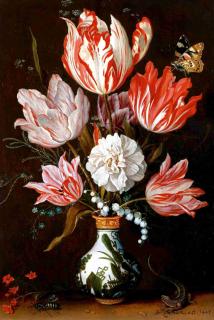

Parrot tulip are striking bulbs, truly spectacular in bloom.
Parrot tulip key facts
Botanical name – Tulipa x gesneriana
Family – Liliaceae
Type – bulb flower
Height – 1½ foot (45cm)
Planting distance – 4-8 in (10-20 cm)
Exposure: full sun – Flowering: late spring
Planting: beginning of fall – Soil: rich, soft, loose, well-draining, cool to dry
With tall foot-and-a-half-high stems (45 cm), the Tulipa × gesneriana Parrot Group boasts fabulous exotic-looking flowers that appear from early May on through June. Each flower averages 5 inches across (12 cm), and what makes them stand out are the ruffled, twisted and fringed petals that come in stupendous colors. Cultivars differ greatly: corollas with mottled colors invoke the bright colors of parrot feathers, hence the “parrot tulip” nickname.
Parrot tulip bulbs are easy to grow in rich, loose soil that has been well-broken up.
It should drain well, but it doesn’t really matter whether it’s on the dry or on the cool side.
Since the flowers are so large, landscapers tend to grow them in flower beds that are set to the side or back of the garden.
Take note, however, that parrot tulip varieties are generally more fragile. They prefer sunny and partly-sunny exposure, and must grow in spots that are protected from the cold and from harsh weather (wind, rain, etc).
A parrot tulip bulb should be planted directly in the ground at the beginning of fall.
Here again, the easiest way to propagate your parrot tulip is to divide the bulb clump.
 When spring arrives, to increase the spectacular blooming even more, remember to give the area special bulb plant fertilizer (with low levels of nitrogen), and to water it regularly. At the end of the season, when the blooming is over, pull the parrot tulip plant out. Indeed, this is a plant issued from breeding and selection, and it should be planted from fresh tulip bulbs again every year.
When spring arrives, to increase the spectacular blooming even more, remember to give the area special bulb plant fertilizer (with low levels of nitrogen), and to water it regularly. At the end of the season, when the blooming is over, pull the parrot tulip plant out. Indeed, this is a plant issued from breeding and selection, and it should be planted from fresh tulip bulbs again every year.
The most dangerous pest that attacks parrot tulips is none other than the squirrel. It will dig the bulbs out from underground for food, and even nibbles on its flowers! Parrot tulip will not appreciate being planted in soggy soil. It can lead to bulb rot. Another disease that might infect it is Botrytis tulipae which causes tulip fire blight.
There are a great many different parrot tulips, each more glorious than the next! For instance:
 the ‘Rainbow’ parrot tulip will produce incredible rainbow-colored flowers;
the ‘Rainbow’ parrot tulip will produce incredible rainbow-colored flowers;>> Similar to parrot tulips are the taller and even more furnished peony tulips.
The love of parrot tulips reaches way back in time, all the way to the 17th century (1600s). What does this tell us about tulips, why are we so mesmerized by its blooming?

The vast and eye-popping range of colors gave this family its name: parrot tulip.
However, bicolor specimens are the ones that garner most attention.
They do have one similarity: all the flowers have a dash of green on their petals.
Parrot tulips are in fact an incredible gift of nature. Those crazy shapes and colors weren’t the result of people trying to create them: they were created by spontaneous mutations in the genes of a completely ordinary tulip. These varieties tend to display huge corollas that reach up to 5 inches across (12 cm). The stamens are a striking deep black color. Petals are twisted or fringed. Often, two colors collide and flame-like patterns appear, chaotic and hypnotic. True jewels for the garden.
Read also: